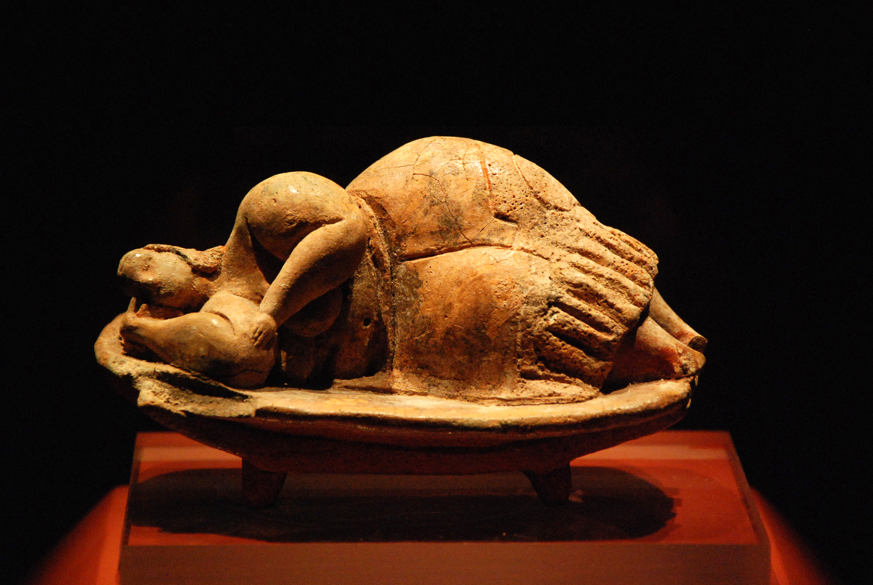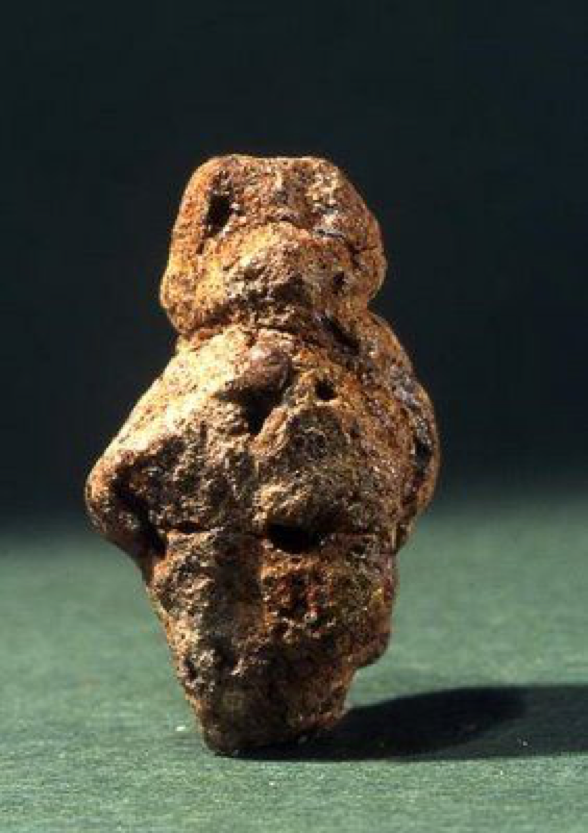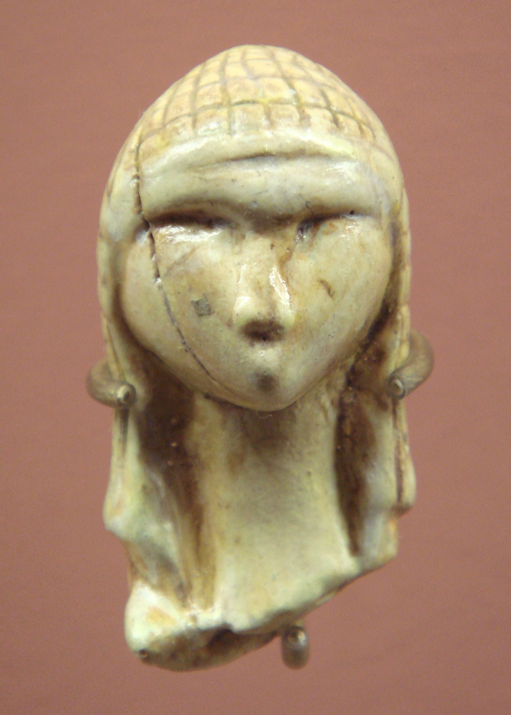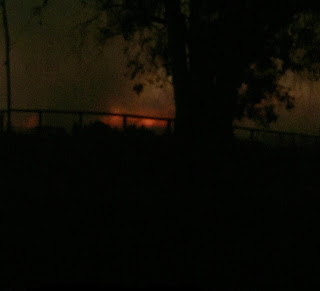The Stone Woman Gives Birth
The Stone Woman Gives Birth (or How to Increase Belly Fat and Dismantle the Patriarchy…you’ll never guess what happens next!)
The stone woman gives birth in the middle of the night. –an ancient Zen koan attributed to Dongshan, China, 9th Century
I have a story to tell you, but it’s a story for which the words have disappeared.
The language that could perhaps tell the story existed long ago, we know of it from certain loanwords that have no roots in Indo-European languages, words like thorax and labyrinth and absinthe and zither, but there exist very few of these words. There is also a written language, called Linear A, that is thought to be related to this early language. It is drawn on clay tablets, but in the time since the first one was found 150 years ago, no one has been able to translate them. I wonder if that’s because the language speaks of things we have no reference for.
There are also songs made up of nonsense syllables that are sung, for instance, in Eastern Europe. These are said to be pre-Christian songs, and their words may not be nonsense, but some of what remains of the old languages. The songs are intense, wild songs. It seems that some of the sounds of the old language came from nature. Which sounds? perhaps water running, owls and songbirds, foxes and trees, roots growing down into hard soil. What do oceans talk about, or trees? What do predators and prey shout to each other in the night? What name does the doe give the fawn as it lies in the grass catching its breath? The language almost certainly knew how to speak of rituals and understandings we have forgotten, including the way death is not an ending, and beings are part of each other.
I say we don’t have the language, but that’s not entirely true. We were all there. That’s one of the things that connects us. A part of every one of us was there. The language and the story are encoded in our DNA, and when we hear it again, we recognize it. We can remember it in our bodies. It doesn’t take much to hear it, it’s just out of reach, sometimes it only takes a smell, new grass, a baby’s hair, morning mist, to tip us off, so much do we long for it. So how could we have ever forgotten?
That’s the mystery, what happened?
The story is long, and so long ago that some parts can only be conjecture. But can you see how it’s shocking and then exciting to imagine that things haven’t always been as they are now?
Around 300,000 years ago hominids carved figurines of round women using volcanic stones, stones the size that would fit in your hand, we have found a few. Would you carry one with you? As an amulet or a companion? Would you hold it for luck? Hominids at that time weren’t known for making art. They fashioned tools with sharp edges, this we knew, and a tool makes sense to us now. What sense do we make of this figurine? There have been many other figurines of women, thousands of them, found in every age and every place, of stone and clay, mammoth ivory, wood, and later, bronze, you can see them in every archaeological museum in the world. So many of them have been found that it’s easy to imagine that a little doll like this was carried by everyone. What would that signify? Like the doll in the fairy tale of Vasilisa the Beautiful, did they feed them and ask them for advice and counsel? And who was she? And what did she know?
The story I want to tell is also to be discovered in the artifacts that have not been found. For a period that lasted tens of thousands of years there is an archaeological record full of conspicuous absences. Here are a few: There are no pictures of war on pottery or cave walls, no weapons for killing each other, nor bones of people killed with weapons, no fortifications, and also no special tombs for rich people or kings or chieftains, though some fancy tombs apparently for priestesses. There are remains of major cities with populations of thousands, lasting millennia, with innovations like indoor plumbing and developed crafts and agriculture and technology, but this sort of thing is absent. Nearly all the figurative art found there is of women and of sacred animals. Male figures are rare and aren’t in the foreground, are never larger than the women, and are often seen as companions or lovers. For at least thirty thousand years, across a vast continent, in hundreds of ancient civilizations, from the Semitic cultures and North Africa in the south, to the Celts in the west, to the Balkans and nearly to Siberia, until these civilizations began to unravel perhaps 4–5 millennia ago, these are the things we see as well as what we don’t see.
If this is the way the world was, I wonder, why no violence? These days humans seem to do anything they are capable of doing. Where was the cruelty? Where was the organized destruction? Why, in these cultures, for tens of thousands of years, is there no evidence of a consuming desire to be better or richer or more powerful than one another? And where are all the men, displaying their aggression and dominance? Was birth itself such a powerful miracle and metaphor? Was nature and a relationship with the earth enough? I have no conclusions. I’m full of wonder, it takes my breath away, and when I sit quietly, I feel both sadness and an inkling that things haven’t always been the way they are now.
Stories from these times seem to be allegories, bread crumb trails through the forest. Like this: God punished Eve when she ate the apple of knowledge, by making her ashamed of her body and by making her give birth in pain. When did we leave the garden? Why did we leave? Before that time, did we give birth without pain? There are Neolithic sculptures of relaxed women seated as if on a throne, giving birth calmly. What if there were no shame about our female bodies, if every birth were a celebration showing the generative and regenerative power of the earth-as-body? Would the context be so different, even our physical bodies be so different, that birth would happen without pain?
Allegories are everywhere, and I find I’ve begun to read the old stories differently. Even the story of the Buddha, whose mother died giving birth to him. As an adult he left the women and his newborn baby at the palace and went out into a world of men and pain and deprivation. Does that point to a much older story? Is that one of the many stories that tries to give us hints about what happened?
It is hard to imagine how this history could have been washed away. It’s almost as if there were a concerted attempt at the time to erase the narrative (although not difficult to imagine that the new civilization would have wanted to erase it). In later mythology, the complex and nuanced stories seem to have been rewritten to make the Goddess a monster, or a harpy or a young and innocent fool, although the complexity rises up through the cracks anyway, in the background mythology, and the stories told by the grandmothers.
What forces could make such a change possible, could create an environment where such a pervasive and powerful culture would become a diaspora, would almost entirely vanish? The record shows a change in climate, ice, then a warming, ocean currents shifting, flooding, drought, these were certainly part of it, bringing with them famine, and perhaps disease. There were volcanic eruptions, too. Thera, a vast volcanic island that became the much more diminutive Santorini, was adjacent to Crete and was almost entirely destroyed, and may have been the source of the myth of Atlantis. Maybe these kinds of events were combined with some apparently benign development, like the domestication of horses on which nomadic raiders could travel great distances. Whatever happened, over the course of a few short millennia, populations migrated away from cities, and figurative art died for centuries, along with civilizations and technology. At this time a new language began to replace the old one, and what had been known about the nature of reality became secret, and eventually became silent. After a while, language and forgetting and cognitive dissonance made this old way of being nearly unknowable.
I’ve never liked the word Goddess. Perhaps it had some sentimentality attached to it that rubbed me the wrong way. Whatever the reason, I recently examined its etymology. I found out that the word Goddess first came into use recently, around 1350 CE, and is a combination of the Germanic derived Godand the Latin ess which means small or female. But further back, much further, you can find the Greek word Potnia (πότνια) which means Lady, a poetic title of honor. For Goddess there was the word Despoina, perhaps from Domus Potnia — the lady of the house, or perhaps De or Deswas a title of divinity. This word Despoina was used like the later Hebrew word Yahweh. It is a stand-in for her real name, the name of the Lady, which is secret, and only told to initiates in mysteries. I don’t know if anyone knows the name today.
I take the loss of this word very personally, and I would like it back.
I have a story to tell, and, like a birth in the middle of the night, there are no words for it. I’ll use the words I have, knowing that they won’t be enough, that they will hold inside them the violence and lies against the story I’m trying to tell. I’ll talk about the pictures, and the feeling of the forms, and I’ll try to describe things that are written in my genes, and in yours. Maybe hearing this awkward telling will make you aware of something you’ve always known. Maybe you will feel like you are coming home from a long exile.
I had a dream where I was looking though a clay bowl I had made. There was no bottom and there was a hole in the table underneath it and in the floor below that and I could see through the bowl, as if through a lens, the people moving around underneath, going about their lives, making things. And I could also see hundreds of grey rats moving over the floor at their feet, as if invisible to everyone, as if out of time, moving in the space between the seconds. No one could see them but me. And once I could see them, I could see them everywhere. There was a different reality, existing concurrently, a rat reality. Rats are an ancient species, outsiders and survivors, they have the ability to thrive while hiding. They recognize danger, they feel emotions, they are altruistic and social. They laugh. The dream showed me the way it’s possible to see through things, that sometimes I miss this, but if I really look, it’s there.
Later on I had a dream in which I had laryngitis, and also couldn’t hear. I could speak but the words came out so quietly that no one could understand, and no one would stop what they were doing to listen. I was there but somehow not synchronized, not in the same time. Things had gone on without me.
It seems important to speak, and to continue speaking. To make art and to continue making art, to create relics for people in the present day, to encourage us, and to be found in midden heaps in 10,000 years. It’s easy to forget things and we live in a time where falsehoods replace reality at the speed of light. But that’s nothing new, the way our past can disappear, we are encouraged to forget, and then the remembering itself is an art.
The other thing that seems important here is what happens to us when we start to see that the foundation on which our reality stood is made of nothing. While it’s disorienting, it’s also exhilarating to experience how we’re connected to everything and everyone, in an unbroken line, to ancestors like these. In meditation, in practices of attention, there is a space that appears that reveals how trivial our beliefs really are. And in that space, possibilities can appear. When we consider the possibility, the likelihood, that things haven’t always been like this, we can begin to choose to make something that has never been before.
That sort of creative gesture is going to be necessary, if we are to survive.
Postscript:
I first came across studies of these early civilizations through the work of Marija Gimbutas when I was in college in the early 1980’s. Her research and analysis and conclusions changed the way I saw the world. A few years ago I was part of an editorial team for a literary magazine and came across a piece that referred to the myth of the maze of the minotaur. I had visited the maze, in Knossos on the island of Crete, in 1992. I was aware from the work of Dr Gimbutas that the story of the minotaur was a bastardization of story of the original matriarchal civilization there, later re-written by the conquerors to obliterate the story of the previous culture, as conquerors often will do.
After I wrote a response to the piece (entitled The Porno of the Conqueror) I was informed by a friend that the work of Dr. Gimbutas had been discredited. I researched that claim and discovered that, although it is a pervasive assertion on the always truthful internet, it has no apparent basis in fact. I found that there is a wealth of misinformation on the subject, especially in certain kinds of particularly repulsive online forums, sometimes spreading to more reputable websites, copied and pasted often enough that it begins to look like everyone agrees. Cognitive dissonance and confirmation bias are vigorous and powerful. Some of Gimbutas’ later work and conclusions have been controversial, but she is universally respected by other archaeologists and subsequent research has served to strengthen her case.
Last year I wrote a paper on the ancient Eleusinian Mysteries, which was an initiation based on the story of Demeter and Persephone, that took place yearly in and around Athens Greece starting around 500 BC and persisting for over 1500 years. Thousands of people participated yearly, women and men, slaves and free, including every great writer, thinker, statesperson, and philosopher of those times. Anthropologists now believe that these rituals went back at least 3000 years, but finding any definitive beginning to the mysteries would be impossible, so ancient were their roots.
If you start to trace the artifacts and recent work of archaeologists and anthropologists and linguists and musicologists and climate scholars and ethnologists, and if you reread the ancient mythology and folk tales, the story of these ancient cultures becomes clearer and the resonance becomes more powerful. While lack of evidence doesn’t constitute evidence to the contrary, as in the evidence of artifacts not found, the conclusion that this was another kind of civilization and world view is compelling.
These stories and artifacts can be found elsewhere, in Africa and Asia and the British Isles among others, but the majority of the research is about the area that’s sometimes called “Old Europe”. Anecdotally it seems like this sort of civilization and these kinds of artifacts are to be found everywhere and comprise the universal origin story. I’m curious to find out if that’s so.
If you care to read more, you could begin with Gimbutas’ The Language of the Goddess, and the posthumous The Living Goddess. Her books are full of detailed drawings of artifacts that illustrate her points. It’s also easy to find photographs of the same artifacts online as well as thousands of others. These pieces are also on view at archaeological museums all over the world. If you travel, Catal Huyuk in Turkey is an example of a city that has been excavated and reconstructed in parts. There are the remains of ancient civilizations on Malta and of some of the other Semitic civilizations in what is now the Golan Heights. There’s also Knossos on Crete, which was the last known civilization of this kind, persisting until 1100 BC.
For a well-considered point by point refutation of the Gimbutas deniers, you can read this article either with automatic translation from Swedish http://gimbutastext.blogspot.com/, or in a condensed form translated by a human person: http://mmstudies.com/scholars/gimbutas-defense/
For a beautiful book about our hominid musical heritage, with a chapter on the music of Old Europe, read Sounding the Depths: Tradition and the Voices of History by Dr. Victor A Grauer.
For recent scholarly work that supports these conclusions see Menotti & Korvin-Piotrovsky 2012; Anthony & Ringe 2015; Lazaridis 2014.
The Origins of Greek Religion (Bristol Phoenix Press — Ignibus Paperbacks) by Dietrich, B.C talks about the early roots of what we usually think of as Greek religion and mythology.
For an example of a modern Ukrainian vocal/instrumental group performing a pre-christian song, probably derived from the old language, go herehttps://www.youtube.com/watch?time_continue=2047&v=Hxg1dL_x0gw
Update: The Potnia Project
Summer 2019
The idea of an undocumented history of cultures that are very different from those of the last 2,000 years has been lying fallow in me for over four decades, but in the face of the 2016 presidential campaign and election and a need to respond, I found myself heading back in that direction. For a while I had been responding to the political situation out of my outrage, gathering information about what may and may not have happened, trying, in my own small way, to help disseminate information, but eventually I lost the taste for it. I wanted to find a way to move forward with a vision that went beyond opposition, toward something powerful and transformative. Perhaps I was looking for the conspiracy beneath the conspiracy, which is just a way of saying I was trying to find out about something buried in the unconscious of the culture, and hidden in my own deep psyche. What came out in this article was tremendously encouraging, to me and to a surprising number of people around me, both women and men.
Since writing this article I have been educating myself further about the things I touched on. Most of the burning questions in that piece -- what happened? Why? -- are still my burning questions, but I have gathered more of the considered opinions regarding them. There’s more evidence and information out there than I could have imagined and I’m just beginning to get below the surface. I have also been exploring cognitive biases that help to explain how we forget and misinform ourselves. Each time I read the word “discredited” I follow up and read carefully the writings of the “experts” who are being cited. They are mostly in the general category of what Gregory Bateson terms “Everybody knows what everybody knows,” with varying degrees of sophistication.
What I tell you three times is true.
– LEWIS CARROLL, The Hunting of the Snark
I continue to follow the breadcrumb trail through the woods when I look at the old and recent work of archaeologists and ancient historians, people who hold bits of the history. The crumbs are getting closer together and I’ve started to gather them, and discover others who are as well. Among the surprising discoveries: a blog post about soldiers returning from the Middle East, talking about how the “goddesses” of ancient Egypt were actually real flesh and blood queens with the power to determine who the Pharaohs would be. Or a mainland Chinese website that told the story of a famous female general of the Shang Dynasty (2000 BCE) who was one of the most influential and powerful of her time, right at the edge of the time when women’s roles in China began to be circumscribed and diminished. There are lots of academic papers by modern archaeologists re-examining the meanings and cultural assumptions we’ve projected onto relics and grave goods, and finding ancient cultures with very different values and structures. I also found a translation of an old Norse verse from the Poetic Edda, the Völuspá (Prophecy of the Witch), that makes reference to the time when the Norse pantheon was faced with the first (ever) war:
“Then all the powers went to the high chairs of fate, the sacrosanct gods, to discuss this: Who had blended the air all with harm? Or to the devourers kind given the Poetry’s Maiden?”
Ah, that’s my question exactly. And was there a time before war? And what happened to end it?
We humans are afraid to believe things that go against our previous understandings, no matter how well-supported. We like what we know even if we don’t like what we know. There is a lot of evidence that there existed in the history of humans a different kind of world, and that our ancestors understood human nature in a radically different way than most of us do now. And, as I said in the article, even lack of evidence isn’t evidence to the contrary. There’s so much that’s still a mystery, so much we need to learn again as a species. Evolution is not proof that the world is as it should be, nor that something very different never existed. Being adaptive in the past doesn’t mean something will always be adaptive, and large changes have occurred, and will occur again. I breathe better when I notice this is possible.
In the last few years I have been making figurines and small animal vessels out of clay, letting my hands tell me what to do. I have been following my body, my intuition. I like this research in all its forms, it’s what inspires me: to find the ways in which we haven’t lost the legacy of this other world, the one that held us for hundreds of thousands of years. I am looking for the past that shows us there’s a way to have a future.









Thank-you Rachel. You have given me a lot to think about and discover.
ReplyDelete